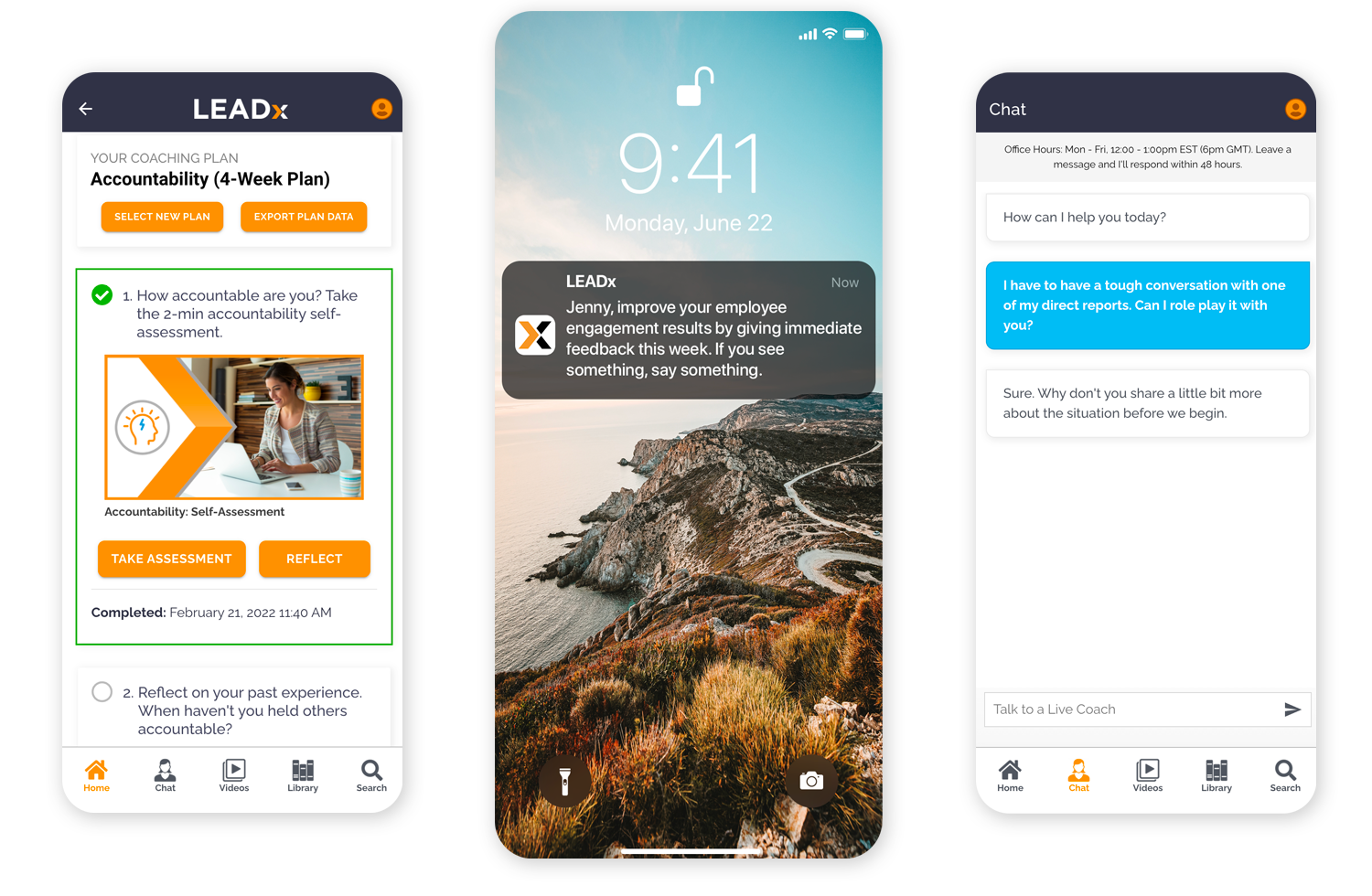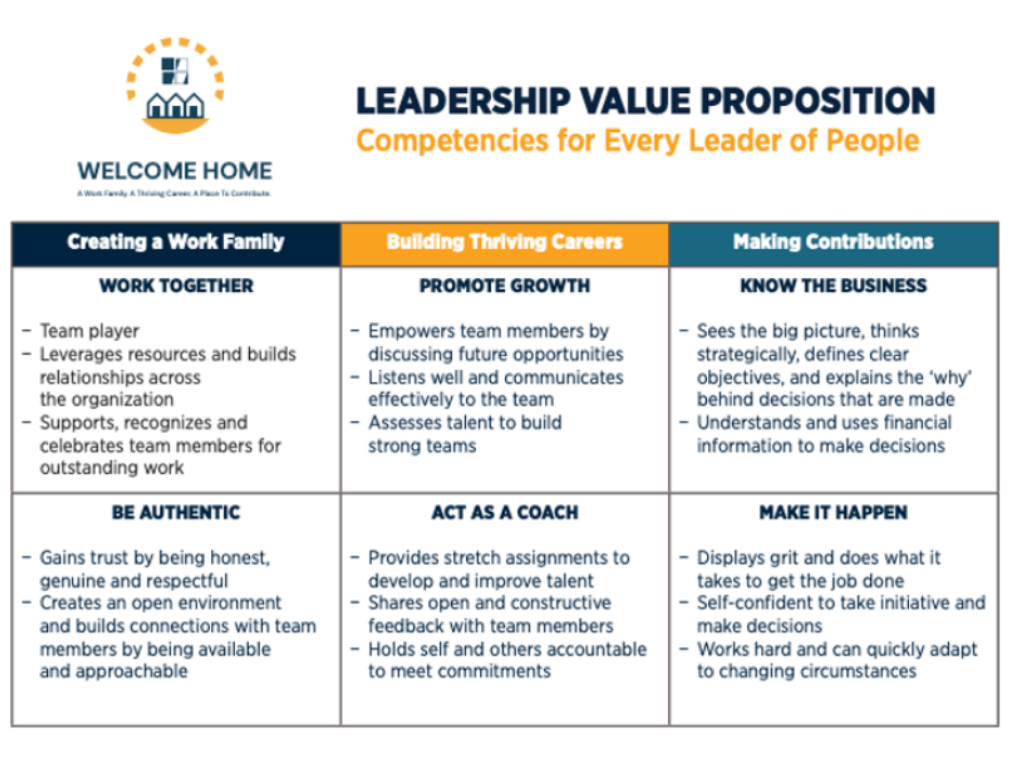
The Ultimate Guide to Middle Management Training Programs
How do you train middle management to set them up for success? What topics should you train? What makes training for middle managers unique from other leaders?
Middle managers are at the heart of an organization, driving everything from bottom-line performance to culture to talent development. Because of their unique position, research shows that developing middle managers can improve your entire organization’s health and set a positive tone in your culture.
Whether you’re evaluating an outside program or getting ready to build your own, here are some of the most important considerations to keep top of mind.
The Unique Opportunities and Challenges of Middle Managers
Middle managers face a constant barrage of opposing agendas, conflicting people, and contradicting expectations. They’re in the very middle of the flow of information—at once strategic and highly tactical. They have to be skilled at leading up, down, and across.
In my interview with Scott Mautz, the author of Leading from the Middle, he described how due to a middle manager’s unique positioning, they have a particularly large impact. Here are some statistics cited in his book:
- Middle managers account for 22% of variation in revenue.
- Replacing a bad middle manager increases productivity by 12%.
- Employees with a strong middle leader are 20% less likely to leave when offered a job elsewhere.
Unfortunately, their great impact often comes at a great cost too:
- They struggle to switch roles constantly (from boss to peer to reportee), and they experience extreme stress and emotional challenges as a result.
- 51% say they worry about work constantly
- 43% describe their job’s pressure as excessive.
Kodak demonstrated just how important middle leaders are to a company’s bottom line and organizational health. The common perception is that the photographic digital revolution swamped Kodak who was a leader in film. In reality, Kodak’s senior executives saw the handwriting on the wall and redesigned their strategy to move into digital photography. But, Kodak’s middle managers didn’t support or implement the new strategy. Their stubbornness caused Kodak to lose its leadership position and ultimately to never recover. Without buy-in from middle management, strategy and culture won’t be put into practice.
Examples of Middle Managers
Also called a “manager of managers” or “leader of leaders,” middle managers make up a large group across a broad range of industries. Middle managers can be a school leader, the head of a hospital department, the leader of a plant, the person leading Learning and Development within the HR department, and so on. Middle-leader roles have varying degrees of responsibility and power, but in all cases they report to someone in senior leadership and lead managers.
Goals of Middle Management Training
As you can see from the broad range of examples, the goals of training middle managers vary a lot based on the organization and the role. In healthcare, your goal might be to impact patient care safety through middle leaders. In our interview with Associa, a community management company, their goal was to help middle managers shift their mindset from doing to a mindset of strategy & delegation.
While there are a number of differences between different types of middle leaders, their position in the middle drums up a lot of the same problems and needs—regardless of how different their industry may be. In the next section of this article, we get into the most common topics that tend to apply universally to middle leaders.
21 Middle Management Training Topics
What follows are 21 of the most common training topics and programs for middle managers and how they can help on the job.
- Conflict management. Because they’re at such a crossroads of people and information, conflict is inevitable. Equip middle managers to manage, mediate, and engage in healthy conflicts.
- Relationship Building. Relationships make up a huge part of a middle manager’s job. Teach middle leaders how to connect, build, and sustain relationships throughout the organization.
- Communication. Middle managers are conduits for information from all sides. Help middle managers excel at their job by communicating clearly and effectively.
- Stress management. A high percentage of middle managers suffer under the load of stress and pressure they face on a daily basis.
- Internal Leadership Development. Nurture leaders in the middle to fill senior positions. Then you’ll have less recruiting to do in the future.
- Mindset shift from producing to leading others. Help leaders see how their responsibilities now extend beyond the realm of “doer” and into the realm of “strategist,” and “delegator.”
- Solving problems across departments. Teach middle leaders the big picture, and how the greater systems work. That way they can excel at problem-solving cross-functionally and help managers below them get the information they need.
- Personality training. Teach leaders about their personality and how it affects their tendencies. This will help them build their self-awareness as leaders.
- Cultural impact. To move beyond the realm of tactical manager, middle managers need to also understand their organization’s culture and how they impact it.
- Tactical leadership execution. Train middle leaders how to execute on the new operational components of their job.
- Emotional intelligence. Self-awareness, self-management, social awareness, and relationship management are all essential skills for a position that revolves around interacting with people at all levels of the organization.
- Time management. Managing time through delegation and prioritization is crucial to middle managers who can easily become overwhelmed and swamped by demands from all directions. They have to be able to manage their time through both short- and long-term goals.
- Creative thinking. Recent research shows that creativity was the single most in-demand skill in 2020. Creative middle managers can problem-solve and find innovative ways to drive the results and strategy of senior leadership.
- Executive presence. Start training middle leaders how to have the credibility and inspirational qualities of a great executive leader. This will help them influence the people around them and it will help prepare them for more senior leadership positions as they become available.
- Delegation. Middle leaders have to get good at delegating and driving outcomes that they know are important.
- Coaching. Middle leaders who are skilled at coaching can deliver more effective feedback, help develop the leaders reporting to them, and inspire.
- Knowing the business. Many middle leaders are promoted for their performance and results. Help them shift toward strategic thinking by training them deeply in your business.
- Empathy. With relationships in every direction, empathy isn’t just a nice-to-have skill for middle managers; it’s essential. Empathy is a powerful skill to help middle managers grow in many of the key areas they’re evaluated on: mentoring, delivering tough feedback, and being influential.
- Building Trust. Middle leaders can help build trust with those reporting to them and help build a culture of trust. In fact, research shows that they’re uniquely poised to build trust within organizations.
- Fostering diversity and inclusivity. When it comes to hiring and mentoring, middle managers can be highly impactful. Ensure middle managers have the skills to develop and coach a diverse group of current talent.
- Finding and growing talent. Middle managers can massively impact the organization if they're skilled at spotting and growing talented people who report to them.
The list of possible competencies and skills that impact middle managers' performance could go on indefinitely. In our experience, many of the most successful middle leader training programs are built in-house because the training can align directly with the competencies, behaviors, and results expected of those specific leaders.
Deltek: A Case Example of These Topics in Action
Deltek’s LEAP (Leadership Engagement with Awesome People) is targeted at director-level leaders. Participants must be nominated and accepted into their four-month-long program. Deltek President & CEO, Mike Corkery, along with other senior executives, lead activities addressing topics like strategic thinking, fostering vision, innovation, employee engagement, influence and persuasion, managing conflict, collaboration, and relationship building. The program concludes with a capstone project in which teams present an innovative solution to an executive panel with the chance for future implementation.
Additional Sources:
Creating A Training and Development Program for Middle Managers
When it comes to creating your own leadership development program for middle management, the possibilities are endless. Aside from the core topics mentioned above, here are seven core considerations to keep top of mind based on our interviews with leadership development professionals:
- Lean on your competency model as you build your training. Instead of choosing topics that will help you with aspects of your competency model, build your programs directly around your competency model. Associa, the biggest provider of community management services in the U.S., does exactly that. They roll out a training program that devotes each week to training a specific competency and the desired behaviors around that competency. The result is a program that spends 100% of the time training exactly the behaviors that middle managers need to succeed at Associa.

- Start with the data and work backward. Meet with middle managers, send out an annual engagement survey, meet with senior leadership. Look for themes across all your data sources. What behaviors do you want to see and how will those behaviors affect the organization’s bottom line? Once you’ve answered that question, you can build a training program that will get the results you want.
Additional Source: How UiPath’s Chief People Officer Uses This Approach
- Cascade leadership development from senior leaders to middle leaders to frontline leaders. At Intuit, VPs kick of training to their directors. When their directors finish training, they cascade their learning down to frontline leaders. The cascade sets the tone, and important behaviors are first modeled by more senior leaders. Another benefit of the cascade is the transfer of knowledge from each group to the next. As people learn and teach, they’re applying what they learned.
- Train middle managers for a year before they become middle managers. At the NCAA, they’ve built what they call “The Pathway Program.” It’s designed to assist those who are ready to become Directors of Athletics or a Conference Commissioner. The Pathway Program is a year-long learning journey where participants work as a small cohort across all three divisions, and take a deep dive into leadership—the mindset, decisions, and actions needed to be successful at that level. They leverage current Directors of Athletics to help train and prepare participants.
- Keep middle managers together in training programs. Even at organizations where the same leadership skills are taught to all leaders regardless of level, putting middle managers through training together in one cohort can help them discuss and apply the training together. This is how Liberty Mutual trains their middle leaders.
- Incorporate nudges and learning that can be done in the flow of work. Middle managers are busy, so don’t rely on “class time” to make training stick. Give them personalized nudges that help them apply what they’re learning on the job.
- Measure improvement. When you set out to change specific behaviors, be sure to measure your progress. You can use 360 assessment tools, self-assessments, or pulses to leaders and their direct reports. UiPath pulses the people reporting to their middle leaders to check on the behaviors they’re looking for. They’ll ask for example, “Did you have a good conversation with your manager recently?”
Impact Middle Leaders to Impact Company Culture
People talk a lot about training from the top down or the bottom up, but what about from the middle out? Training top to bottom can be difficult because senior leaders tend to be disconnected from the day-to-day action, and bottom-up can be difficult because employees don’t have the same influence as leaders. Middle leaders, however, can influence culture up, down, and with their peers; influencing in all those directions is already an integral part of their job.







